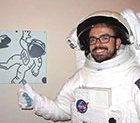
Overview
In this activity, students will gain a better understanding of where space begins. They will use a map scale to determine the relative distance to space from the surface of a map. They will then stack coins the appropriate height to mark the edge of space.
Materials
- State or county maps with scale distance bars (can be printed or displayed from online maps) OR download Los Angeles area map (PDF)
- Various coins, metal washers, or other thin stackable items
- Ruler with millimeter markings
Management
- Students will need printed maps with a scale bar displayed. Maps can be printed from online mapping services. Be sure to select the printing options that include scale bars. You can also download and print this Los Angeles area map.
- Local maps, such as city maps, may have scale bars that are too short (i.e., show too few miles per length of the scale bar) making it impractical to stack coins high enough to display the scale distance to space accurately. Maps covering a larger area work best.
- Prior to the lesson, identify several landmarks, cities, or other known features that are about 62 miles from your school. These will be used as a distance reference.
Tips for Remote Instruction
- Students can print a map at home, or place a sheet of paper on a computer screen and gently trace the outline of a map and the scale bar.
- Students using tablet computers can open a map on the device, lay it flat, and stack coins on the screen. In this case, it may help to take a screengrab of the map and access it on the device's photo gallery, so that students don't accidentally change the interactive map view.
Background
We often think of space as being very far away. Planets are many millions or even billions of miles away, and stars are so far away that their distances are measured in light years. (A light year is the distance light travels in a year and is equal to six trillion miles.) Yet the edge of space – or the point where we consider spacecraft and astronauts to have entered space, known as the Von Karman Line – is only 62 miles (100 kilometers) above sea level.
Watch en Español: Seleccione subtítulos en Español bajo el ícono de configuración. | Watch on YouTube
During its 35 years of operation, NASA’s Space Shuttle operated at 190 miles to 330 miles (304 kilometers to 528 kilometers) above sea level, depending on its mission. The International Space Station maintains an orbit approximately 250 miles (400 kilometers) above sea level, while the Hubble Space Telescope operates at an altitude of about 340 miles (550 kilometers).
Procedures
Ask students how far they would have to travel from the surface of Earth to reach space. After several responses, tell students that the distance to the edge of space is 62 miles above sea level. Mention the altitude of the International Space Station and the Hubble Space Telescope. Share several landmarks, cities, or other notable features that are approximately 62 miles from your school or city. You can also reference locations students may know that are farther than 62 miles to make a point that those places are farther from them than the edge of space.
Based on their measurements, students should now determine what 62 miles on the scale bar equals in millimeters. There are a variety of ways to find this answer, depending on the math concepts with which students are familiar. For simplicity, students could determine how far 60 miles on the scale bar is in millimeters.
Discussion
- Why do you think getting to space is so difficult when it’s only 62 miles away?
Answer: Space is 62 vertical miles away. It takes a lot of energy to overcome gravity for that distance and gain the speed required to stay in orbit (approximately 17,500 miles per hour) once you've arrived. - How would the distance to space be different from Denver compared with Los Angeles?
Answer: The distance to space from Denver is approximately 61 miles while it's about 62 miles to space from Los Angeles. This is because Denver is 1 mile above sea level while Los Angeles is close to sea level.
Assessment
- Students should be able to correctly measure the scale distance bar on the map in millimeters.
- Students should be able to correctly determine how far 62 (approximately 60) scale miles spans in millimeters.
- Students should be able to correctly stack coins to the scale height representing approximately 60 miles.
Extensions
- Ask students to make a stack of coins reaching the altitudes of the following objects orbiting Earth: International Space Station: 250 miles (400 km) Hubble Space Telescope: 340 miles (550 km)
- Ask students to make a stack of coins reaching the altitude of the ASTHROS balloon mission at 130,000 feet.
- Ask students to determine how high a stack of coins would need to be to represent the distance from Earth’s surface to the Moon, which orbits 238,855 miles (384,400 kilometers) away.
- Ask students to determine how high a stack of coins would need to be to represent the distance from Earth’s surface to the James Webb Space Telescope, which will be stationed about 1,000,000 miles (1,600,000 kilometers) away.
- Give students the opportunity to explore additional scale distance activities from the list below.
Explore More
About the Author

Lyle Tavernier
Educational Technology Specialist, NASA-JPL Education Office
Lesson Last Updated: Oct. 21, 2024










